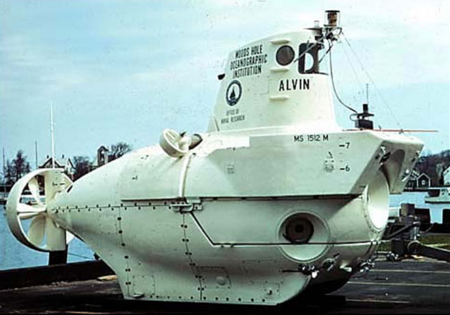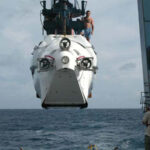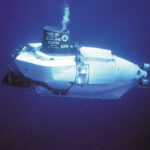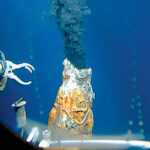Alvin
Ship
Modern
Quick Facts:
Alvin was the first manned deep-sea submersible – a vessel capable of taking crew down to the ocean floor.
Introduction
In earlier days, men would travel by ship and go explore new areas themselves. When underwater exploration began, we had to rely on machines to travel down to collect and bring information back. One scientist, however, understood that the best way to learn about any part of the ocean was for researchers to go there themselves.1 This idea helped create new vessels capable of carrying people deep underwater.
History and Development
Alvin was the first deep sea manned submersible vessel. This means it is capable of carrying passengers, usually a pilot and two observers, down into deep ocean depths. Earlier submersibles were often large and not always easy to move and guide. Allyn Vine was a oceanographer who worked for the Woods Hole Oceanographic Institution or WHOI. He proposed the idea in 1956 that the best way to learn about the ocean was to travel down there. A joint project between WHOI, the US Navy and other companies began in 1962 to build a manned submersible research vessel. On June 5, 1964, Alvin was commissioned. In honor of Allyn Vine’s work and effort, they named the submersible Alvin after him by combing the first two letters of his first name (ALlyn) with the three first letters of his last name (VINe). Bud Froehlich, Allyn Vine, and Bill Rannie made the first dive on August 4, 1964, and went down 35 feet.2
Alvin has made over 4,600 dives in its career, and has been instrumental in underwater exploration.3 Thanks to Alvin scientists have recorded about 300 new species of animals.4 Alvin has also made several dives down to the Titanic to photograph and help document the wreck site. In 1977, Alvin helped discover hydrothermal vents. Like geysers on land, these vents underwater become heated by magma – similar to lava – and spray out minerals into the ocean.5 One of Alvin’s most notable dives was in February of 1966 when it was used to help locate four bombs. A bomber plane crashed off the coast of Spain with the bombs on board. Alvin aided in the search and recovery, and they were found. These numerous dives to the ocean floor give marine researchers a first eye account of what lies in the depths of the sea.
Design and Construction
Much like a space shuttle is built to survive in harshness of outer space, Alvin is built to withstand the crushing pressure of the deep ocean. Alvin looks like a small submarine and has received many upgrades since being built in 1964. It requires a crane to be lowered into and lifted from the water. Today, the vessel weighs 35,200 lbs. It is 23 ft. long, 12 ft. high, and a little over 8 ½ ft. wide. It has thrusters to help it move in different directions while underwater. There are also three large, thick portholes on the portside (left), starboard (right) and forward (front). Two robotic arms are attached, and able to lift up to 200 lbs. The vessel is equipped with lights to see in the dark waters, electronic equipment to help navigate, and sensors for read sample collections in live time.6
Images
Endnotes
- Robert D. Ballard and Will Hively, The Eternal Darkness: A Personal History of Deep-Sea Exploration, (Princeton: Princeton University Press, 2000), p. 72
- “History of Alvin,” Woods Hole Oceanographic Institution [WHOI], accessed April 27, 2017, http://www.whoi.edu/page.do?pid=10737.
- “Alvin,” National Oceanic and Atmospheric Administration [NOAA], accessed August 4, 2017, http://oceanexplorer.noaa.gov/technology/subs/alvin/alvin.html.
- “Alvin.”
- “Hydrothermal Vents,” Woods Hole Oceanographic Insitution [WHOI], accessed August 4, 2017, http://www.whoi.edu/main/topic/hydrothermal-vents.
- “Alvin.”





